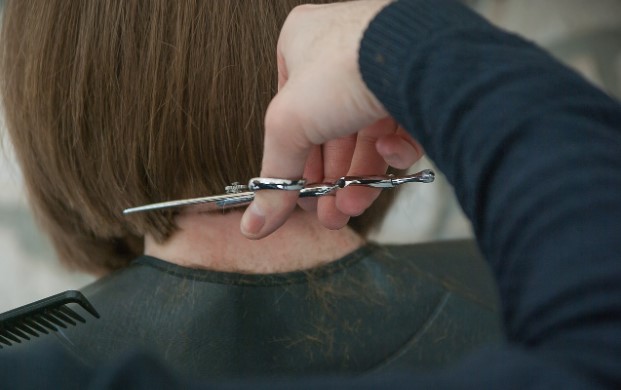Welcome to the exciting world of haircutting! This guide is designed to equip beginners like you with the foundational skills and confidence needed to create stunning haircuts. Whether you’re aiming to craft simple trims or aspire to more complex styles, our essential tips and techniques will set you on a path to becoming proficient in the art of hair sculpting.
Navigate Your Gear
Before you start cutting hair, familiarizing yourself with your tools is crucial. Your primary gear includes scissors, clippers, combs, and hairdressing capes. Understanding how pros use thinning shears to make hair look fuller and remove bulk will also come in handy as you progress. Each tool has its unique function — scissors are essential for cutting and shaping, clippers are used for precise hair lengths and fades, and combs help in sectioning and guiding the hair during cuts. Begin by understanding how each tool feels in your hand – comfortable handling is key to precision and safety.

Practice opening and closing the scissors smoothly, and get accustomed to the weight and vibration of the clippers. Remember, the quality of your tools significantly affects the outcome of haircuts, so investing in professional-grade equipment is advisable. Proper care and maintenance of your gear will ensure their longevity and reliability in every haircut you undertake.
Learn the Basic Techniques
There are certain skills every hairdresser in the business should master because without them, creating a great haircut is nearly impossible. Knowing what these are and learning how to perform them with ease will greatly improve your confidence and efficiency. Here are the techniques you simply must know:
- Blunt cut
- Point cutting
- Layering
- Texturizing
- Thinning
- Graduation
- Fringe (bangs) cutting
- Undercut
- Textured bangs
- Clipper cutting
These skills ensure versatility in creating a wide range of haircuts, enhance precision in each cut, and build the confidence needed to experiment with more complex styles. Essentially, they are the building blocks that enable hairdressers to meet diverse client needs with professionalism and creativity.
Practice
For hairdressers, consistent practice is crucial for several reasons. Firstly, it helps in refining their cutting techniques, ensuring that every cut and style is done with precision and confidence. Secondly, practice enables hairdressers to familiarize themselves with a variety of hair types and cutting scenarios, preparing them for the range of client requests they will encounter. Lastly, regular practice aids in developing muscle memory, making the physical aspects of haircutting more intuitive and less mentally taxing over time.
To effectively practice, hairdressers should start by using mannequin heads; this allows them to experiment with different haircuts and styles without the pressure of working on a real client. Additionally, setting regular practice sessions and dedicating time to focus on specific techniques or styles can accelerate skill development. Seeking feedback from more experienced colleagues and participating in workshops or classes can also provide fresh insights and improve techniques.
Understand Face Shapes
Understanding face shapes influences the suitability of haircuts and styles for individual clients. Each face shape — be it oval, round, square, heart, or diamond — has specific hairstyles that enhance its features and create a harmonious look. By recognizing the nuances of each shape, hairdressers can tailor haircuts that flatter their clients’ unique facial structures, thus boosting client satisfaction and confidence.
To research this effectively, hairdressers should study face shape guides in beauty and hairstyling books, attend professional workshops, and utilize online tutorials. Engaging with fellow professionals on forums and social media platforms also offers insights and tips on mastering this crucial aspect of hairstyling.
Research Hair Texture
Hair texture varies from fine to coarse, and straight to curly, each requiring different techniques and tools for optimal results. Knowledge of texture affects decisions on cutting methods, styling approaches, and product recommendations, ensuring personalized and effective hair solutions for clients. To research hair texture, hairdressers can utilize a blend of hands-on experience, educational cosmetology books, and professional workshops.
Online platforms, including instructional videos and forums, provide diverse insights into managing various hair textures. Engaging with a community of hair professionals through social media or industry events also facilitates the exchange of tips and techniques, enriching a hairdresser’s understanding and expertise in handling different hair textures.
Consult with Customers
Consulting helps you understand client’s needs, preferences, and concerns before beginning any haircut or style. It sets the stage for a successful outcome by aligning the hairdresser’s expertise with the client’s vision. Effective consultation involves actively listening to the client, asking questions about their desired look, lifestyle, and haircare routine, and providing professional advice on what styles would best suit their face shape and hair texture.
Visual aids like pictures can help clarify expectations. This collaborative approach ensures the client feels heard and contributes to their satisfaction, fostering trust and building a loyal clientele.

Congratulations on evolving through the foundational stages of haircutting. Every technique you’ve mastered, each tool you’ve wielded with confidence, and the understanding you’ve cultivated about face shapes, hair textures, and client consultations, empowers you to craft beautiful, customized styles. Remember, your journey in hairstyling is perpetual, where practice and passion will continually refine your artistry and elevate your creations to new heights.






